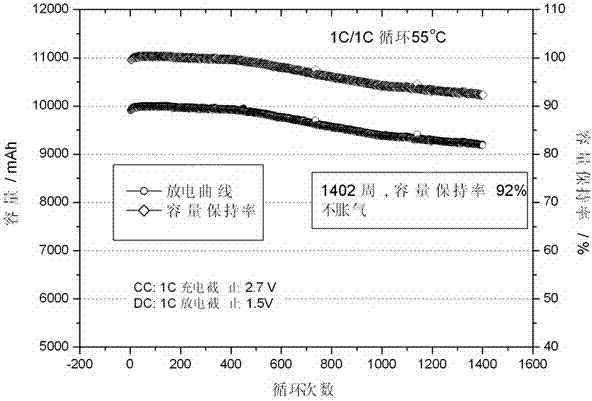Method for solving high-temperature flatulence of lithium titanate negative lithium-ion battery
A lithium ion battery, lithium titanate technology, applied in electrical components, battery pack components, circuits, etc., can solve problems such as battery short circuit, achieve the effect of solving the problem of flatulence, excellent rate charging and discharging performance, and avoiding battery short circuit
- Summary
- Abstract
- Description
- Claims
- Application Information
AI Technical Summary
Problems solved by technology
Method used
Image
Examples
Embodiment 1
[0021] (1) Making positive and negative electrodes: the positive electrode material (polyvinylidene fluoride 7%, superconducting carbon black 5%, LiNi 1 / 3 co 1 / 3 mn 1 / 3 o 2 The remainder) is dispersed in an organic solvent (N-methylpyrrolidone), stirred evenly and coated on the positive electrode current collector, dried at 80°C and rolled to obtain a thickness of 200 μm and a compacted density of 3 g / cm 3 positive electrode sheet; disperse the negative electrode materials (2% sodium carboxymethyl cellulose, 8% styrene-butadiene rubber, 4% superconducting carbon black, and the rest of lithium titanate) in water, stir evenly and coat on the negative electrode current collector , after drying at 100°C, the thickness is 120μm, and the compaction is 2g / cm 3 When coating, the capacity per unit area of the positive electrode: the capacity per unit area of the negative electrode = 1.2:1; put the above-mentioned electrode sheet in a vacuum oven and bake at 125°C for 23 hours, t...
Embodiment 2
[0030] (1) Making positive and negative electrodes: the positive electrode material (polyvinylidene fluoride 7%, superconducting carbon black 5%, LiNi 1 / 3 co 1 / 3 mn 1 / 3 o 2 The remainder) is dispersed in an organic solvent (N-methylpyrrolidone), stirred evenly and coated on the positive electrode current collector, dried at 50°C and rolled to obtain a thickness of 100 μm and a compacted density of 2.8 g / cm 3 positive electrode sheet; disperse the negative electrode materials (2% sodium carboxymethyl cellulose, 8% styrene-butadiene rubber, 4% superconducting carbon black, and the rest of lithium titanate) in water, stir evenly and coat on the negative electrode current collector , after drying at 90°C, the thickness is 60μm and the compaction is 1.8g / cm 3 When coating, the capacity per unit area of the positive electrode: the capacity per unit area of the negative electrode = 1.05:1; put the above-mentioned electrode sheet in a vacuum oven and bake at 120°C for 22 hours,...
Embodiment 3
[0036] (1) Making positive and negative electrodes: the positive electrode material (polyvinylidene fluoride 7%, superconducting carbon black 5%, LiNi 1 / 3 co 1 / 3 mn 1 / 3 o 2 The remainder) is dispersed in an organic solvent (N-methylpyrrolidone), stirred evenly and coated on the positive current collector, dried at 100°C and rolled to obtain a thickness of 350 μm and a compacted density of 3.4 g / cm 3 positive electrode sheet; disperse the negative electrode materials (2% sodium carboxymethyl cellulose, 8% styrene-butadiene rubber, 4% superconducting carbon black, and the rest of lithium titanate) in water, stir evenly and coat on the negative electrode current collector , after drying at 120°C, the thickness is 200μm, and the compaction is 2.4g / cm 3 When coating, the capacity per unit area of the positive electrode: the capacity per unit area of the negative electrode = 1.5:1; put the above-mentioned electrode sheet in a vacuum oven and bake at 130°C for 24 hours, then c...
PUM
| Property | Measurement | Unit |
|---|---|---|
| thickness | aaaaa | aaaaa |
| particle diameter | aaaaa | aaaaa |
| thickness | aaaaa | aaaaa |
Abstract
Description
Claims
Application Information
 Login to View More
Login to View More - R&D
- Intellectual Property
- Life Sciences
- Materials
- Tech Scout
- Unparalleled Data Quality
- Higher Quality Content
- 60% Fewer Hallucinations
Browse by: Latest US Patents, China's latest patents, Technical Efficacy Thesaurus, Application Domain, Technology Topic, Popular Technical Reports.
© 2025 PatSnap. All rights reserved.Legal|Privacy policy|Modern Slavery Act Transparency Statement|Sitemap|About US| Contact US: help@patsnap.com

